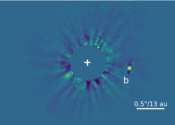New technique helps search for another Earth (Update)
The quest to find another world that sustains life has been boosted by a technique that should let less expensive ground-based telescopes join the search, a study said on Wednesday.

The quest to find another world that sustains life has been boosted by a technique that should let less expensive ground-based telescopes join the search, a study said on Wednesday.
Astronomy
Feb 3, 2010
0
0

(PhysOrg.com) -- New observations from the Herschel Space Observatory show a bizarre, twisted ring of dense gas at the center of our Milky Way galaxy. Only a few portions of the ring, which stretches across more than 600 ...
Astronomy
Jul 20, 2011
17
0

Because it's bigger, Jupiter ought to have larger, more spectacular rings than Saturn has. But new UC Riverside research shows Jupiter's massive moons prevent that vision from lighting up the night sky.
Planetary Sciences
Jul 21, 2022
0
130

Using the Giant Metrewave Radio Telescope (GMRT), astronomers from South Africa and Poland have conducted radio observations of a giant radio galaxy (GRG) known as J0133−1302. The observational campaign revealed that the ...

(Phys.org)—A new view of a 20,000-year old supernova remnant demonstrates the upgraded imaging power of the National Science Foundation's (NSF) Karl G. Jansky Very Large Array (VLA) and provides more clues to the history ...
Astronomy
Jan 19, 2013
0
0

A two-year cycle in the gamma-ray brightness of a blazar, a galaxy powered by a supermassive black hole, has been confirmed by 10 years of observations from NASA's Fermi Gamma-ray Space Telescope. The findings were announced ...
Astronomy
Oct 18, 2018
2
218

Sometimes kids ask really simple questions – and parents have no idea what the answers are. When one of our colleagues was asked what it sounds like on the planet Uranus, she was stumped. And so were we! So we asked an ...
Space Exploration
Apr 2, 2019
3
29

(PhysOrg.com) -- Many, perhaps even most stars, are members of binaries -- two stars that orbit each other. Symbiotic stars are a small subset of binaries with an attitude: they display characteristic, dramatic, episodic ...
Astronomy
Feb 22, 2010
0
0

Astronomers using two Maunakea Observatories—Subaru Telescope and W. M. Keck Observatory—have discovered a key benchmark brown dwarf orbiting a sun-like star just 86 light-years from Earth that provides a key reference ...
Astronomy
Dec 14, 2020
0
349

Principal Investigator George Ricker likes to call it the "Goldilocks orbit"—it's not too close to Earth and her Moon, and it's not too far. In fact, it's just right.
Space Exploration
Jul 31, 2013
0
0